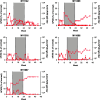Optimized Adeno-Associated Viral-Mediated Human Factor VIII Gene Therapy in Cynomolgus Macaques
- PMID: 29890905
- PMCID: PMC12199626
- DOI: 10.1089/hum.2018.080
Optimized Adeno-Associated Viral-Mediated Human Factor VIII Gene Therapy in Cynomolgus Macaques
Abstract
Hemophilia A is a common hereditary bleeding disorder that is characterized by a deficiency of human blood coagulation factor VIII (hFVIII). Previous studies with adeno-associated viral (AAV) vectors identified two liver-specific promoter and enhancer combinations (E03.TTR and E12.A1AT) that drove high level expression of a codon-optimized, B-domain-deleted hFVIII transgene in a mouse model of the disease. This study further evaluated these enhancer/promoter combinations in cynomolgus macaques using two different AAV capsids (AAVrh10 and AAVhu37). Each of the four vector combinations was administered intravenously at a dose of 1.2 × 1013 genome copy/kg into five macaques per group. Delivery of the hFVIII transgene via the AAVhu37 capsid resulted in a substantial increase in hFVIII expression compared to animals administered with AAVrh10 vectors. Two weeks after administration of E03.TTR packaged within the AAVhu37 capsid, average hFVIII expression was 20.2 ± 5.0% of normal, with one animal exhibiting peak expression of 37.1% of normal hFVIII levels. The majority of animals generated an anti-hFVIII antibody response by week 8-10 post vector delivery. However, two of the five macaques administered with AAVhu37.E03.TTR were free of a detectable antibody response for 30 weeks post vector administration. Overall, the study supports the continued development of AAV-based gene therapeutics for hemophilia A using the AAVhu37 capsid.
Keywords: adeno-associated virus; factor VIII; hemophilia A; monkey.
Figures






Similar articles
-
Characterization of Adeno-Associated Viral Vector-Mediated Human Factor VIII Gene Therapy in Hemophilia A Mice.Hum Gene Ther. 2017 May;28(5):392-402. doi: 10.1089/hum.2016.128. Epub 2017 Jan 5. Hum Gene Ther. 2017. PMID: 28056565
-
Intravenous magnesium sulphate and sotalol for prevention of atrial fibrillation after coronary artery bypass surgery: a systematic review and economic evaluation.Health Technol Assess. 2008 Jun;12(28):iii-iv, ix-95. doi: 10.3310/hta12280. Health Technol Assess. 2008. PMID: 18547499
-
Drugs for preventing postoperative nausea and vomiting in adults after general anaesthesia: a network meta-analysis.Cochrane Database Syst Rev. 2020 Oct 19;10(10):CD012859. doi: 10.1002/14651858.CD012859.pub2. Cochrane Database Syst Rev. 2020. PMID: 33075160 Free PMC article.
-
Prophylactic platelet transfusion for prevention of bleeding in patients with haematological disorders after chemotherapy and stem cell transplantation.Cochrane Database Syst Rev. 2012 May 16;2012(5):CD004269. doi: 10.1002/14651858.CD004269.pub3. Cochrane Database Syst Rev. 2012. PMID: 22592695 Free PMC article.
-
Adefovir dipivoxil and pegylated interferon alfa-2a for the treatment of chronic hepatitis B: a systematic review and economic evaluation.Health Technol Assess. 2006 Aug;10(28):iii-iv, xi-xiv, 1-183. doi: 10.3310/hta10280. Health Technol Assess. 2006. PMID: 16904047
Cited by
-
Comparison of Gene Delivery to the Kidney by Adenovirus, Adeno-Associated Virus, and Lentiviral Vectors After Intravenous and Direct Kidney Injections.Hum Gene Ther. 2019 Dec;30(12):1559-1571. doi: 10.1089/hum.2019.127. Epub 2019 Dec 3. Hum Gene Ther. 2019. PMID: 31637925 Free PMC article.
-
Prednisolone and rapamycin reduce the plasma cell gene signature and may improve AAV gene therapy in cynomolgus macaques.Gene Ther. 2024 Mar;31(3-4):128-143. doi: 10.1038/s41434-023-00423-z. Epub 2023 Oct 13. Gene Ther. 2024. PMID: 37833563 Free PMC article.
-
Determining the Minimally Effective Dose of a Clinical Candidate Adeno-Associated Virus Vector in a Mouse Model of Hemophilia A.Hum Gene Ther. 2022 Apr;33(7-8):421-431. doi: 10.1089/hum.2021.108. Epub 2021 Dec 8. Hum Gene Ther. 2022. PMID: 34652966 Free PMC article.
-
Functional enhancer elements drive subclass-selective expression from mouse to primate neocortex.Cell Rep. 2021 Mar 30;34(13):108754. doi: 10.1016/j.celrep.2021.108754. Cell Rep. 2021. PMID: 33789096 Free PMC article.
-
Clinical Considerations for Capsid Choice in the Development of Liver-Targeted AAV-Based Gene Transfer.Mol Ther Methods Clin Dev. 2019 Sep 10;15:170-178. doi: 10.1016/j.omtm.2019.08.015. eCollection 2019 Dec 13. Mol Ther Methods Clin Dev. 2019. PMID: 31660419 Free PMC article. Review.
References
-
- Rangarajan S, Walsh L, Lester W, et al. AAV5-factor VIII gene transfer in severe hemophilia A. N Engl J Med 2017;377:2519–2530. - PubMed
-
- Sullivan SK, George LA, Ragni MV, et al. SPK-8011: preliminary results from a Phase 1/2 trial of investigational gene therapy for hemophilia confirm transgene derived increases in FVIII activity that are persistent and stable beyond eight months. Mol Ther 2018;26:163.
LinkOut - more resources
Full Text Sources
Other Literature Sources
Research Materials
Miscellaneous

